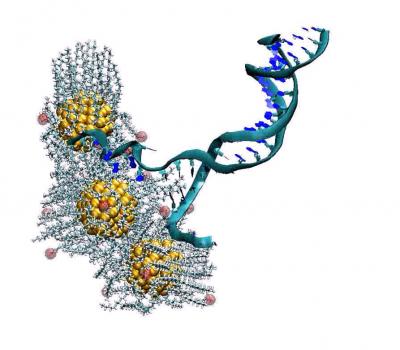Research carried out at North Carolina State University to identify better methods for genetic material packaging to aid in gene therapy has led to findings that could significantly impact gene therapy research and DNA-based electronics.
 Gold Nano particles pulling on DNA (Credit:Yaroslava Yingling, North Carolina State University)
Gold Nano particles pulling on DNA (Credit:Yaroslava Yingling, North Carolina State University)
Gene therapy is a treatment method for specific medical conditions where the relevant DNA cells are modified. The research team found that DNA’s double helix structure could be unzipped by positively charged gold nanoparticles.
Gold nanoparticles measuring 1.5 nm in diameter were introduced into a solution comprising double stranded DNA. The research team coated the gold nanoparticles with organic molecules that are labeled as ligands. The ligands were either positively charged or hydrophobic. DNA always holds a negative charge. The oppositely charged DNA and gold nanoparticles were attracted to one another to form complex packages. However, the hydrophobic ligands which repel water became enmeshed with each other. This caused the nanoparticles to be pulled into clusters, ultimately unraveling the DNA they were attached to.
Dr. Yaroslava Yingling, co-author of the research paper and assistant professor at North Carolina for materials science and engineering, highlighted the need for customizing the charge, ligands and chemical composition of the materials involved to preserve the structural integrity of DNA. DNA-based electronics is an emerging field that aims to create nano scale electronic circuits by adopting DNA as a template. It involves the process of attaching metal nanoparticles to DNA. The findings from the study serve to caution researchers to thoroughly analyze the properties of the nanoparticles they employ in order to mitigate the risk posed to the DNA’s structural integrity.